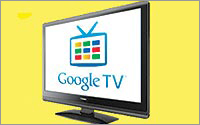 Google began releasing an update for YouTube on Google TV Sunday. The rollout should take several days to complete. The new features are strongly focused on
making it easier for viewers to navigate channels to find video content.
Google began releasing an update for YouTube on Google TV Sunday. The rollout should take several days to complete. The new features are strongly focused on
making it easier for viewers to navigate channels to find video content.
The tools also allow viewers to become more social by rating videos, as well as adding comments or content to
playlists. Engineers at the Mountain View, Calif. company are also continuing to work on a dedicated Google+ app for Google TV, which is expected to debut soon.
Social features and the ability
to easily access content through connected devices -- also known as smart TVs -- drives demand on YouTube. While consumers are still awaiting high-quality content subscription services, a Google
spokesperson said the company has "nothing to announce at this time."
About 42 million consumers globally watch TV shows and movies from an Internet-connected television, according to research
from Strategy Analytics.
Indeed, adoption to Internet-connected TVs continues to grow, although slowly. Findings from a Deloitte survey of 2,215 U.S. consumers in late 2011 found that only 14%
stream movie content to a computer or television as part of a paid subscription model, and only 12% can view content via an Internet-connected TV.
Could Google TV apps support a subscription
service? Xyologic, a search engine for app stores launched Monday, paints a picture of apps gaining in popularity and those experiencing failure. The
research firm has been following apps on Google TV since August 2011.
Since then, 64 exclusive apps have been added. According to the company's analysis, nearly 5
million apps have been installed, with six that come pre-installed on Google TVs. Only 352,000 Google TV exclusive Android apps have been downloaded so far. The top apps in terms of installations
include Napster, Pandora, CNBC, TV & Movies, Photos, Twitter, Redux, CNNMoney, Maps, MotorTrend, and Thuuz Sports.
For now, Google TV YouTube content relies on an ad-supported model. Some
of the ad formats on YouTube are available on Google TV, such as pre-roll ads, but Google engineers are working to integrate the full suite of YouTube ad options, such as TrueView, an ad model that
doesn't change the advertiser for the impressions unless the ad runs for more than 30 seconds.
Internet-connected TVs are not the only means for accessing content. In another study released last year, Strategy Analytics found that 65% of U.S.-based weekly Xbox users under the age of
25 access online TV shows and movies from their game console, even more than from a desktop or notebook PC screen.
Easy access to content could also drive advertising for Google. As consumers
change the way they consume media, so will platform providers such as Google's YouTube, making a paid-subscription service seem inevitable. After all, YouTube boasts that it has logged more than 1
trillion views in 2011. Advertisers can only imagine what that might mean for a paid-subscription Internet-connected TV service.
Earlier this year at the Consumer Electronics Show (CES),
Louisa Shipnuck, director of marketing and strategy at Verizon Digital Media Services, said she would reconnect with Google to get more information on the content offered through its Google TV
Internet-connected service.
While the goal is to help viewers navigate through the channels more easily, software bugs such as the TV suddenly turning off or on continue to dampen sales of the
Internet-connected device. The next version of Google TV should produce much better results than the first, according to sources, but it won't come from the hardware manufacturer Sony. The maker of
PlayStation, Walkman and other electronic devices signed over bragging rights to Samsung.